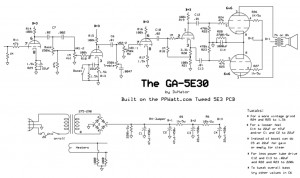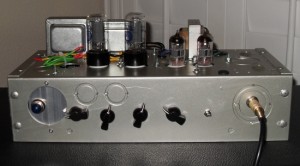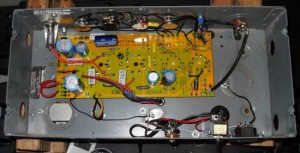![]()
This is another amp using the 5E3 PCB from ppwatt.com. I am physically or mentally unable to build a 5E3 using a 5E3 board as that would make sense. So, instead I built something else very loosely based on a Gibson GA30rvt. This is the thread on PPWatt.com. These boards can be purchased here.
I was interested in the Gibson because of it’s unusual tone controls. I especially wanted to try the bass control which is also in the Matchless Chieftain. The bass control is a sort of variable coupling capacitor. It turns out that it works really well and is great for going from humbuckers to single coil pickups.
The treble control from the GA30rvt didn’t do as well for me. In this amp it was way too bright. The GA30rvt treble control adds a small cathode bypass cap to boost the highs and this amp was already bright. I changed it to a simple treble roll off and it works great in this amp. This type of treble control is also used in the Matchless Chieftain. I also tried the mid control but I really didn’t care for it so it was yanked.
The amp uses a cathodyne PI with some tweaks compared with the cathodyne in the 5E3. 100k resistors instead of 56k and a 3.3k bias resistor. I have a 1 meg resistor before the PI and 47k grid stoppers on the power tubes. It’s a relatively tight sounding output section for a cathodyne inverter.
The transformers are ones I had lying around and wanted to find a use for. The output transformer is from a Blues Jr. I don’t think it sounds too bad but doesn’t have the girth for much low end. The PT is a Weber reverb transformer with a separate Radio Shack transformer for the heaters.
It’s built in an old fuse box I got for a couple bucks in a thrift store. So, all told, not a major investment in this amp but it came out good. It’s a fairly basic design but it’s effective. With the three cascaded stages it can get some nice gain happening and cover Marshall to tweedish Fender tones pretty nicely.
Here are a couple video demos and no, I’m not going to win any awards for cinematography. They both start out with the clean tone and switch to an overdriven tone about half way through.
Some Pics:
And Clips:



Leave a Reply
You must be logged in to post a comment.